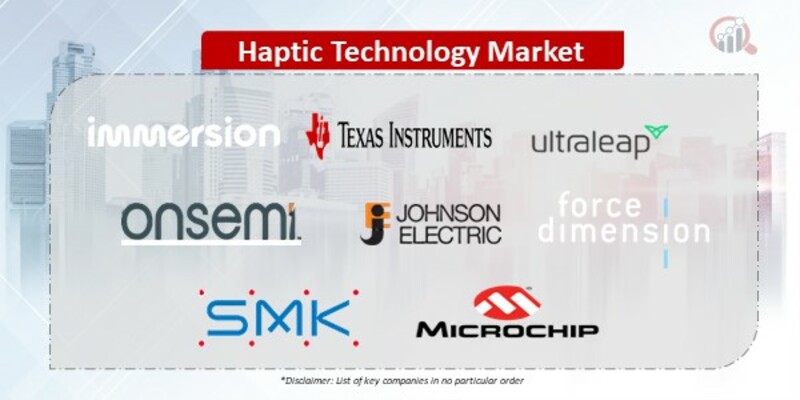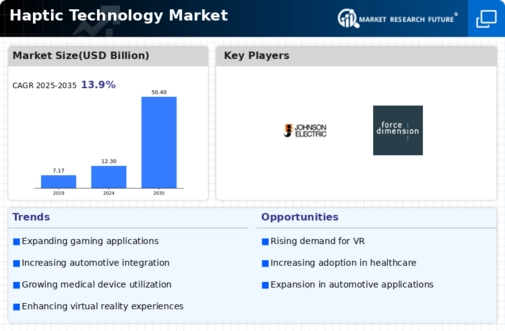Top Industry Leaders in the Haptic Technology Market

The Competitive Landscape of the Haptic Technology Market
The haptic technology market is no longer a futuristic vision; it's a tangible reality pulsating with innovation. This burgeoning space, where technology mimics touch, is attracting established tech giants, nimble startups, and niche players eager to capitalize on the growing demand for tactile experiences. Understanding the competitive dynamics, adopted strategies, key players, and emerging trends is crucial for navigating this exciting and rapidly evolving landscape.
Some of the Haptic Technology companies listed below:
- Immersion Corporation
- Texas Instruments Incorporated
- Ultrahaptic (Ultraleap)
- Haption S.A.
- ON Semiconductor Corporation
- Johnson Electric
- SMK Corporation
- Microchip Technologies Incorporated
- Synaptics Incorporated
- Force Dimension
Strategies Adopted by Leaders:
- Embracing Open Standards and Interoperability: Adherence to open standards like ISO 18899 or Haptics Working Group ensures widespread compatibility and opens up the market to a broader range of developers and applications.
- Prioritizing Software Optimization and Development Tools: Providing robust software development kits (SDKs), driver support, and performance optimization tools empowers developers to leverage the full potential of the hardware, attracting a wider user base.
- Investing in R&D and Pushing the Tactile Boundaries: Continuous innovation with next-generation actuators, novel materials for realistic textures, and advanced algorithms for precise feedback is crucial for maintaining market leadership in this rapidly evolving space.
- Partnerships and Ecosystem Building: Collaborating with other players in the technology ecosystem, such as game developers, hardware manufacturers, or virtual reality platform providers, expands reach and offers comprehensive solutions.
- Focus on Specialized Applications and Niche Markets: Targeting specific applications like medical haptic feedback for surgery training, VR training simulations, or high-end gaming controllers can carve out a profitable niche in the market.
Factors for Market Share Analysis:
- Product Portfolio and Technological Breadth: The range and sophistication of haptic actuators offered, from simple vibration motors to intricate microfluidic-based feedback systems, significantly impact market reach. Offering high-fidelity textures, temperature sensations, and precise force feedback can be significant differentiators.
- Target Market Focus: Catering to specific segments like gaming, AR/VR, automotive interfaces, or medical simulations requires tailored solutions and partnerships. Addressing the unique needs of each segment can solidify market share within that niche.
- Integration and Compatibility: Seamless integration with existing hardware and software platforms, including compatibility with major game engines and operating systems, expands potential customers and fosters broader market adoption.
- Brand Reputation and Trust: In a dynamic technical domain, a strong brand built on reliability, technical expertise, and a proven track record in haptic technologies inspires confidence among demanding users. Established players like Texas Instruments and Johnson Electric Holdings often have an edge in this regard.
- Pricing Strategy and Value Proposition: Striking the right balance between affordability and feature depth is essential. Offering flexible pricing models like licensing technologies, component sales, or subscription services for cloud-based haptics can broaden appeal and increase market share.
New and Emerging Companies:
- Specialized Haptic Solutions Startups: Companies like Ultrahaptics and Basis Inside focus on developing high-fidelity mid-air haptic technologies, offering touchless interaction and immersive experiences for applications like AR/VR and retail displays.
- Software-Centric Players: Companies like Haptics.js and HaptX develop software platforms and middleware that enable developers to seamlessly integrate haptic feedback into their applications, democratizing access to the technology.
- Wearable Haptics Specialists: Companies like Sensive Interactive and OVR Technology focus on haptic gloves and wearable interfaces, opening up new possibilities for tactile feedback in gaming, medical rehabilitation, and training simulations.
Latest Company Updates:
November 2023- Immersion Corporation, a popular provider and developer of patents for haptics, of late revealed that they have signed with Razar a multi-year license for making patents of Immersion accessible to Razar’s laptop computers, AR/VR products, and gaming computer peripherals. The company’s high-quality feedback technology improves gaming peripherals & applications. Haptics increasingly is being added to gaming apps with majority of the vendors incorporate top quality tactile effects for a highly immersive operation.
February 2023- Kanpur has signed a technology transfer agreement with Ambrane India Private Ltd for mass manufacturing & sale of haptic smart watch for the visually impaired and blind people. This watch will make an excellent social impact via allowing the blind & visually impaired for making seamless usage of the technology for daily use. This watch will be commercialized soon by Ambrane India & will be accessible in the market at a pocket friendly cost. It is a fusion of vibration and tactile watches. The usage of innovative haptic icons in fact makes it simpler in navigating the menu and simple gesture such as the double-tap may open a specific health monitoring app.
January 2023- Gurgaon reached a vital milestone in the knee & hip replacement through the introduction of the world’s most largely adopted US FDA approved Mako RoboticArm Assisted Technology lately. It has been installed at W Pratiksha Hospital. The company is committee in bringing the best-in-class technology for improving patient outcomes and believes that this technology is a class apart with regards to clinical outcomes. The haptic technology will allow lesser soft tissue injury.








